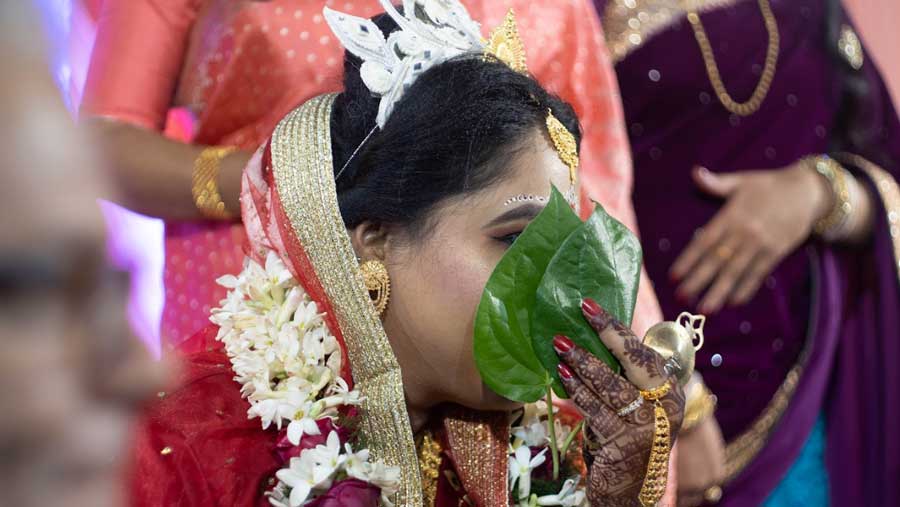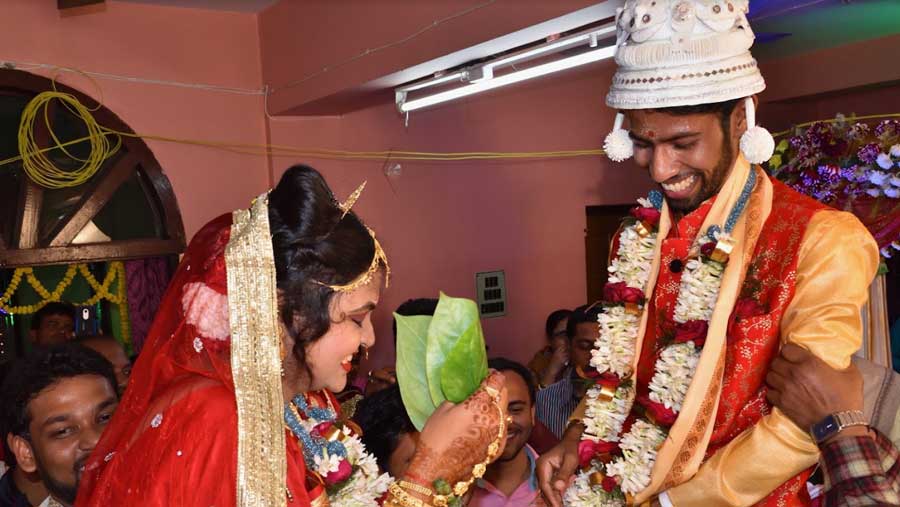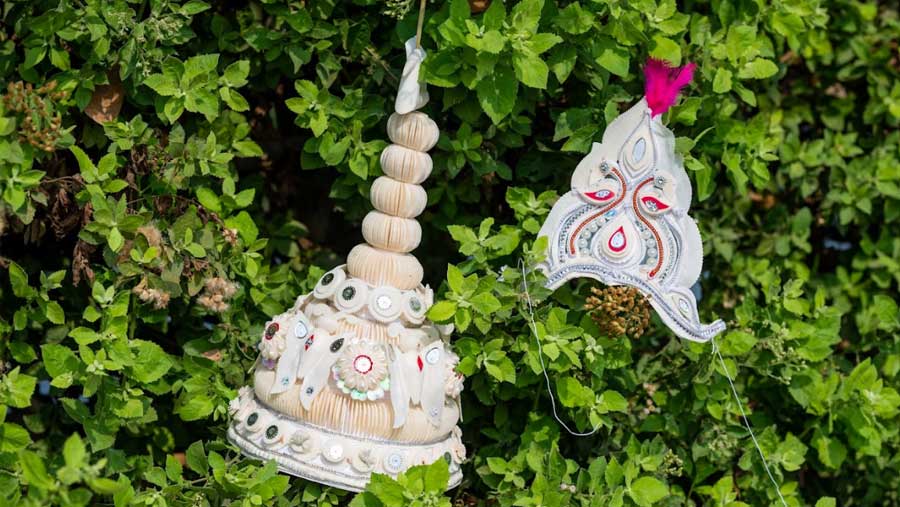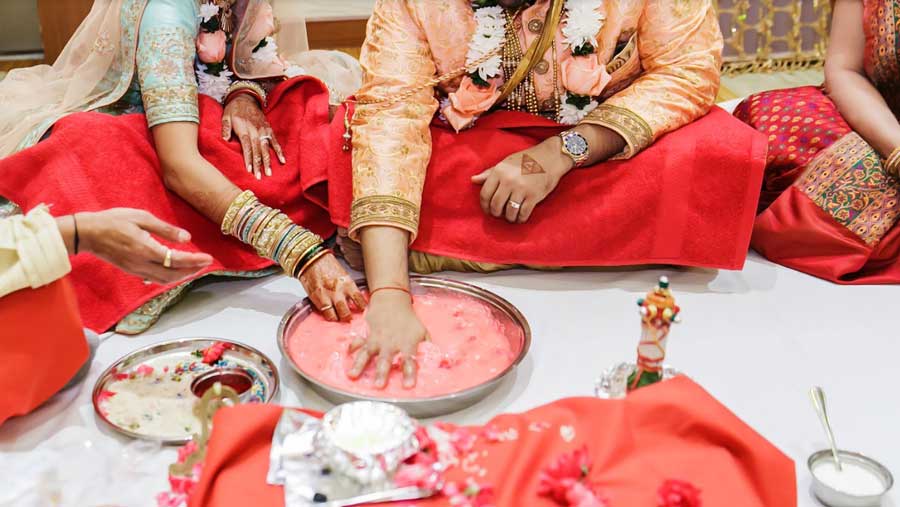Winter has set in and there is a nip in the air. And we all know what that means – it’s time for those wedding invitations to start pouring in! If you too know someone who’s getting married this season, here is a quick handy list of some popular but quirky traditions that you can expect at a traditional Bangali biye.
The one at the ‘chadna tola’
Most of us are somewhat familiar with this particular tradition. The bride is seated on a wooden seat (called peeri in Bengali), and covers her face with two betel leaves. This seat is then lifted by her brothers or cousins who carry her this way to the chadna tola, which is a special area where the groom stands waiting for her.

The bride covers her face with betel leaves before being taken to the ‘chadna tola’ Memories Over Mocha / Shutterstock.com
Before the bride removes the betel leaves from in front of her face, her cousins are supposed to carry her around the groom seven times, with family and friends keeping count (sometimes even purposely miscounting, so they keep on going!) before finally coming to a stop in front of the groom. Following this, the bride removes the betel leaves in a ritual known as shubho drishti.
The one where they figure out who is taller
The chadna tola is also the spot for another fun tradition, which perhaps draws the loudest cheers from all those watching. After the shubho drishti, and before the exchange of garlands, the bride and groom are made to sit on their individual peeris before being lifted high up by cousins and friends, in a bid to figure out who is taller.

The game is played after ‘Shubho Drishti’ SOMNATH MAHATA / Shutterstock.com
Amidst chants of “Bor boro na bou boro?” (Who is taller, the groom or the bride?), the room erupts with shouts of encouragement from both sides of the family. The bride and groom hold on to whatever they find (including people’s hair, clothes, etc.), to keep themselves from toppling over. Later on, when the families sit down to look at the wedding photographs, the candid snapshots from this particular tradition usually draws the loudest laughs.
The one with the missing shoes
Although not exclusive to Bengali weddings, this tradition is still an important one, and unlike other traditions, does not directly involve the bride and the groom. Once the groom takes off his shoes and heads to the wedding mandap for the ceremony, cousins from the bride’s side of the family (usually females), aim to steal the shoes and hide them away. So that when the ceremony is over, the groom is unable to leave the venue!
And if all you Bollywood buffs think that this sounds familiar, you’re not wrong. The 1994 Salman Khan and Madhuri Dixit-starrer, Hum Aapke Hain Koun..! had a similar scene.
Known as joota chupai in Hindi, and juto churi in Bengali, the game comes to an end when after the ceremony, the shoes are held ransom by the bride’s cousins and are only returned back to its rightful owner for a handsome amount of money!
The one where they stay up all night
The night of the wedding is known as the bashor raat, where the bride and groom, along with their siblings, cousins and friends, spend all night playing games and chatting. An opportunity for the young members from both sides of the family to get to know each other, the bashor raat often acts as an ice-breaker of sorts, with people bonding over team games like antakshari, dumb charades and more!
The one with the ‘mukut’ and ‘topor’
Traditional Bengali wedding attire includes headgears for both the bride and the groom, called mukut and topor, respectively. For this tradition, the tips of these headgears are broken and then gently set adrift in a bowl of swirling water. If the tip from the mukut leads the way with the topor following behind, it is predicted that the husband will follow the wife in their married life and if it is the other way around, then vice versa. (All in good humour, of course!)

Headgear worn by the groom (front) and bride (back) Shutterstock
The one where they fish for the ring
Like joota chupai, this tradition is not exclusive to Bengali weddings and is followed in other cultures as well. The husband’s family hides a gold ring in a large bowl filled with milk, flower petals, coins and water that has been stained red by adding alta. Both husband and wife are then supposed to look for the ring in the bowl and the one who fishes it out first gets to keep it!

The bride and the groom are supposed to look for a ring in the water Shutterstock
The one where they clean up the mess
For this tradition, five small earthen pots are filled with rice, turmeric and shells. The bride and the groom are then seated on the ground and asked to take turns toppling the pots. After one of them topples, it is the job of the other person to neatly collect all the ingredients and put them back inside the pot. A true test of patience, elders in the family believe that the one who is able to collect back every last remaining grain of rice, will be the more organised one in the family.

If the bride spills the contents in the pot, the groom is supposed to collect it back and vice versa Shutterstock
So, this wedding season, as you plan your outfits and map out your dinner at the buffet (don’t forget the fish fry and the mangsho-pulao!), make sure to also indulge in some of the fun and frolic surrounding these typical biye bari traditions.
